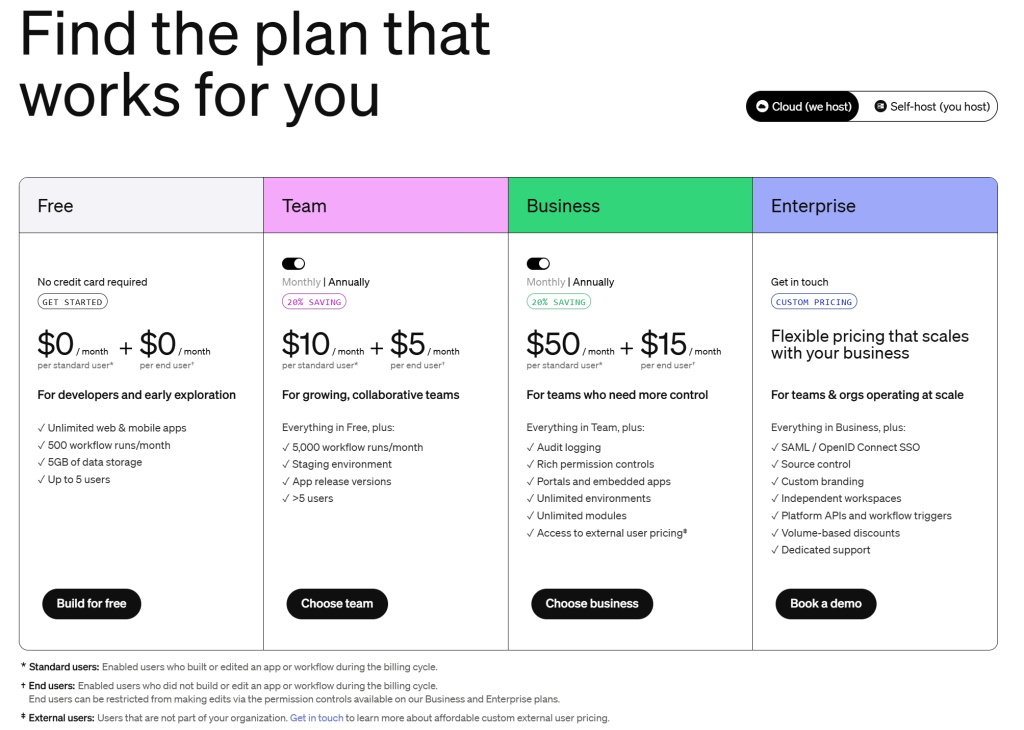Retool Pricing: How Much Does Retool Cost?
Retool is an internal tools builder that has evolved into a comprehensive software development environment for business software. Retool is an increasingly popular choice by dev teams who don’t want to spend their days building admin panels from scratch and ship internal tools faster.
In this article, we analyze Retool pricing by tier and go through a few scenarios to estimate the annual cost of Retool-built apps. How much does Retool cost?
TL/DR: Retool’s pricing consists of three elements: users, hosting, and features. Its annual cost is variable and depends on how you combine these three elements. Other internal tool builders, such as Five, offer a fixed monthly fee per application, eliminating the guesswork from calculating the annual cost of custom-built internal tools.
A Step-by-Step Guide to Retool’s Pricing

Step 1: Understanding Users
Before we delve into Retool’s pricing plans, let’s discuss users.
In the world of internal tool builders, such as Retool, AppSmith, Superblocks, or Five, users are an important concept and have a direct impact on pricing.
In the case of Retool, there are three types of users:
- Standard Users: standard users are users who build or edit an app. An easier way to think of a standard user is to call them developers.
- End Users: end users do not develop or edit an app, but only use applications developed in Retool. End users typically share the same email domain as standard users, i.e. they are from the same organization, but they are not developers.
- External Users: external users are application users who are not part of your organization. For example, suppliers, vendors, or business partners are external users.
So, the first question to answer when evaluating Retool’s pricing is this:
Question 1: How many standard, end, and external users do I expect on the platform?
Step 2: Understanding Retool’s Hosting Options
Retool’s gives two options for hosting: managed hosting (Retool hosts your applications) and self-hosting (you host your applications developed in Retool).
These two hosting options have a direct impact on pricing. If you choose to self-host, Retool’s more affordable plans are capped at 25 users.
Question 2: Where will my Retool application be hosted: on their servers or my servers?
Step 3: Understanding Features and Inclusions
Retool’s pricing plans come with different features and inclusions. We won’t go into every feature and inclusion for every plan, but will only focus on two:
- Permissions and access control: Who can view and edit what data? Retool defines this as “data-level and role-based permissions for granular control over app and data access.”
- Audit logs: Is there an application audit trail? Retool defines this as “Track every query run against your databases and APIs, as well as user actions taken in Retool.”
Both of these features are only included in Retool’s Business plan. While simple applications, such as a read-only sales tracker dashboard, can probably do without an audit log, permissions are critical to almost every application.
Question 3: What features do I need from Retool? Are permissions, access controls and audit logs important to my application?
Step 4: Putting It All Together
Let’s put it all together and compare a few pricing scenarios. All numbers stated in this article are taken from Retool’s pricing website as of the time of writing and stated in US$, on an annual subscription plan.
1. The Start-Up Scenario: I have no more than 5 users, who are a mix of developers and end users. Everyone can access everything.
Great. With less than five users, you can use Retool for free, regardless of hosting.
2. The Scale-Up Scenario: We are a team of 2 developers and plan to build an app for 8 end users in my sales department.
Choose the Team plan at an annual cost of US$720. The annual cost will be the same regardless of hosting. If you require audit logs, the annual cost increases to US$2,640 per year.
3. The Medium-Sized Company Scenario: I have 3 developers, and plan to build an app for 15 end users. I also need audit logging and permissions.
Choose the Business plan at an annual cost of US$4,500 per year. Every additional end user will add US$180 in cost per year.
4. The Business Partner Portal Scenario: We plan to build a business partner portal with dozens of external users.
Retool only lets you have annual users on their Business plan and does not disclose the annual fee per external user. On the Business plan, the annual cost per standard user is US$600, plus US$180 per end user. Presuming you have two developers working on the business partner portal, your minimum cost will be US$1200+.
Retool’s Pricing: Pros and Cons
Retool’s pricing can seem difficult to understand, but once you break it down into three parts – users, hosting, and features – it’s quite easy to predict the annual cost of an application developed in Retool.
With its pricing, Retool has succeeded in making the cost of custom-built internal tools comparable to off-the-shelf SaaS solutions.
Off-the-shelf SaaS solutions, such as CRM systems, for example range from US$10 (Odoo) to US$90 (Hubspot) per user and month. Retool’s pricing per end-user is within the same ballpark, and its end-user pricing appears relatively cheap.
The disadvantage of pricing per user is that it may create the wrong incentive in the development process. Who should be included or excluded from the application? Projects can get sidetracked by discussions of whether granting access to a certain user is worth the cost.
Retool is also not suited for large groups of anonymous users. Its pricing also gets expensive once you require access control for your application, a critical feature in application development. As your team grows, your Retool application will also become costlier to run.
Last, Retool is not suited for building applications that you plan to sell or monetize.
If you are looking for a more predicable alternative offering a fixed monthly subscription fee per application, Five, a rapid development environment for internal tools is the right choice.
Five offers a transparent fixed monthly fee per application, starting from as little as US$27.49 per app/month, without limits on internal or external users.
Further Reading
Learn more about Retool and how it stacks up against other platforms in our comprehensive comparison of Retool alternatives.


